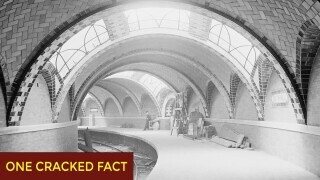One Man's Nose Protected The Subway From Gas (And Elephants)

Subways are dangerous places if you have lungs. Quite a few gases are heavier than the mixture that we call "air," so if a poisonous gas gets loose in the city, there's a good chance it will settle down in the subway. Today, we have sophisticated instruments for monitoring the air quality down there. In 1920s New York, they had James.
James "Smelly" Kelly was a foreman at the Board of Transportation, and he led a team checking the tunnels out. He and his five assistants walked the tunnels five times a day for over 20 years, each covering a daily distance of 10 miles. Guiding them was a series of not-terribly-sophisticated instruments of Kelly's own invention and also just own extremely sophisticated nose. The top priority was sniffing out gas, which could poison people or ignite. He spotted other dangers too.
Like leaks. Pipes crack, and as water made its way through walls, Kelly (sometimes also nicknamed "Leaky Kelly"), would spot the problem before it got too far. He'd place a stethoscope to the walls and listen for unwanted sounds and also carried a separate contraption he called an Aquaphone, which used a telephone handset.
Don't Miss
He also spotted eels. Before the water treatment system figured out how to use grates to keep unwanted stuff out, fish would swim into the plumbing. Kelly regularly spotted large fish clogging the pipes up, some a foot long, and he once found a 2.5-foot eel.
One time, he visited a subway stop and announced the source of the smell there: elephants. "Uh, okay," said people, slowly stepping away. Clearly, Smelly Kelly has lost touch with reality. But no: It was elephants. Years before, New York's theater district had hosted circuses, and they'd buried loads of elephant dung. Now, a burst pipe had mixed with the fossilized dung and deposited the foul mixture on the subway platform, where only Kelly could identify it.
This fact came from the new One Cracked Fact newsletter. Want more like this, straight from your email inbox, without any ads or popups? Join here:
For more jobs of the past, try reading:
4 Old-Timey Jobs That Could Solve the Unemployment Crisis
6 Familiar Jobs (That Once Looked Crazy As Hell)
5 Ordinary Jobs That Used To Be Crazy Dangerous
Follow Ryan Menezes on Twitter for more stuff no one should see.
Top image: Library of Congress
